Art & Culture: Puppet Forms of India
by
Mentors4ias
·
May 18, 2019
Introduction:
- A puppet is one of the most remarkable and ingenious inventions of the man. It has been said that a puppet has to be more than his live counterpart for it is definitely the suggestive element that is more captivating and enduring in a puppet.
- Ancient Hindu philosophers have paid the greatest tribute to puppeteers. They have likened God Almighty to a puppeteer and the entire universe to a puppet stage. Srimad Bhagavata, the great epic depicting the story of Lord Krishna in his childhood say that with three strings-Satta, Raja and Tama, the God manipulates each object in the universe as a marionette.
- India is said to be the home of puppets, but it is yet to awaken to its unlimited possibilities. The earliest reference to the art of puppetry is found in Tamil classic ‘Silappadikaaram’ written around the 1st or 2nd century B.C.
- Natyashastra, the masterly treatise on dramaturgy written sometime during 2nd century BC to 2nd century AD., does not refer to the art of puppetry but the producer-cum-director of the human theatre has been termed as ‘Sutradhar’ meaning the holder of strings. The word might have found its place in theatre-terminology long before Natyashastra was written but it must come from marionette theatre. Puppetry, therefore, must have originated in India more than 500 years before Christ.
- Almost all types of puppets are found in India. Puppetry throughout the ages has held an important place in traditional entertainment. Like traditional theatre, themes for puppet theatre are mostly based on epics and legends. Puppets from different parts of the country have their own identity. Regional styles of painting and sculpture are reflected in them.
- Stories adapted from puranic literature, local myths and legends usually form the content of traditional puppet theatre in India which, in turn, imbibes elements of all creative expressions like painting, sculpture, music, dance, drama, etc. The presentation of puppet programmes involves the creative efforts of many people working together.
Different Types of Puppets:
String Puppets:
- India has a rich and ancient tradition of string puppets or marionettes. Marionettes having jointed limbs controlled by strings allow far greater flexibility and are, therefore, the most articulate of the puppets. Rajasthan, Orissa, Karnataka and Tamil Nadu are some of the regions where this form of puppetry has flourished.

- Kathputli, Rajasthan: The traditional marionettes of Rajasthan are known as Kathputli. Carved from a single piece of wood, these puppets are like large dolls that are colourfully dressed. Their costumes and headgears are designed in the medieval Rajasthani style of dress, which is prevalent even today. The Kathputli is accompanied by a highly dramatised version of the regional music. Oval faces, large eyes, arched eyebrows and large lips are some of the distinct facial features of these string puppets. These puppets wear long trailing skirts and do not have legs. Puppeteers manipulate them with two to five strings which are normally tied to their fingers and not to a prop or a support.
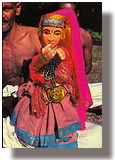
- Kundhei, Orissa: The string puppets of Orissa are known as Kundhei. Made of light wood, the Orissa puppets have no legs but wear long flowing skirts. They have more joints and are, therefore, more versatile, articulate and easy to manipulate. The puppeteers often hold a wooden prop, triangular in shape, to which strings are attached for manipulation. The costumes of Kundhei resemble those worn by actors of the Jatra traditional theatre. The music is drawn from the popular tunes of the region and is sometimes influenced by the music of Odissi dance.

- Gombeyatta, Karnataka: The string puppets of Karnataka are called Gombeyatta. They are styled and designed like the characters of Yakshagana, the traditional theatre form of the region. The Gombeyatta puppet figures are highly stylized and have joints at the legs, shoulders, elbows, hips and knees. These puppets are manipulated by five to seven strings tied to a prop. Some of the more complicated movements of the puppet are manipulated by two to three puppeteers at a time. Episodes enacted in Gombeyatta are usually based on Prasangas of the Yakshagana plays. The music that accompanies is dramatic and beautifully blends folk and classical elements.

- Bommalattam, Tamil Nadu: Puppets from Tamil Nadu, known as Bommalattam combine the techniques of both rod and string puppets. They are made of wood and the strings for manipulation are tied to an iron ring which the puppeteer wears like a crown on his head.A few puppets have jointed arms and hands, which are manipulated by rods. The Bommalattam puppets are the largest, heaviest and the most articulate of all traditional Indian marionettes. A puppet may be as big as 4.5 feet in height weighing about ten kilograms. Bommalattam theatre has elaborate preliminaries which are divided into four parts – Vinayak Puja, Komali, Amanattam and Pusenkanattam.
Shadow Puppets:
- India has the richest variety of types and styles of shadow puppets. Shadow puppets are flat figures. They are cut out of leather, which has been treated to make it translucent. Shadow puppets are pressed against the screen with a strong source of light behind it. The manipulation between the light and the screen make silhouettes or colourful shadows, as the case may be, for the viewers who sit in front of the screen. This tradition of shadow puppets survives in Orissa. Kerala, Andhra Pradesh, Karnataka, Maharashtra and Tamil Nadu.
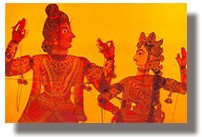
- Togalu Gombeyatta, Karnataka: Tholu Bommalata, Andhra Pradesh’s shadow theatre has the richest and strongest tradition. The puppets are large in size and have jointed waist, shoulders, elbows and knees. They are coloured on both sides. Hence, these puppets throw coloured shadows on the screen. The music is dominantly influenced by the classical music of the region and the theme of the puppet plays are drawn from the Ramayana, Mahabharata and Puranas.
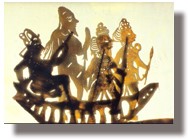
- Ravanachhaya, Orissa: The most theatrically exciting is the Ravanachhaya of Orissa. The puppets are in one piece and have no joints. They are not coloured, hence throw opaque shadows on the screen. The manipulation requires great dexterity, since there are no joints. The puppets are made of deer skin and are conceived in bold dramatic poses. Apart from human and animal characters, many props such as trees, mountains, chariots, etc. are also used. Although, Ravanachhaya puppets are smaller in size-the largest not more than two feet have no jointed limbs, they create very sensitive and lyrical shadows.
Rod Puppets:
- Rod puppets are an extension of glove-puppets, but often much larger and supported and manipulated by rods from below. This form of puppetry now is found mostly in West Bengal and Orissa.
- Putul Nautch, West Bengal: The traditional rod puppet form of West Bengal is known as Putul Nautch. They are carved from wood and follow the various artistic styles of a particular region. In Nadia district of West Bengal, rod-puppets used to be of human size like the Bunraku puppets of Japan. This form is now almost extinct. The Bengal rod-puppets, which survive are about 3 to 4 feet in height and are costumed like the actors of Jatra, a traditional theatre form prevalent in the State. These puppets have mostly three joints. The heads, supported by the main rod, is joined at the neck and both hands attached to rods are joined at the shoulders.
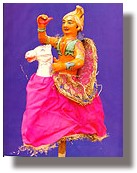
- Yampuri, Bihar: The traditional Rod puppet of Bihar is known as Yampuri. These puppets are made of wood. Unlike the traditional Rod puppets of West Bengal and Orissa, these puppets are in one piece and have no joints. As these puppets have no joints, the manipulation is different from other Rod puppets and requires greater dexterity.
Glove Puppets:
- Glove puppets, are also known as sleeve, hand or palm puppets. The head is made of either papier mache, cloth or wood, with two hands emerging from just below the neck. The rest of the figure consists of a long flowing skirt.
- These puppets are like limp dolls, but in the hands of an able puppeteer, are capable of producing a wide range of movements. The manipulation technique is simple the movements are controlled by the human hand the first finger inserted in the head and the middle finger and the thumb are the two arms of the puppet. With the help of these three fingers, the glove puppet comes alive.
- The tradition of glove puppets in India is popular in Uttar Pradesh, Orissa, West Bengal and Kerala. In Uttar Pradesh, glove puppet plays usually present social themes, whereas in Orissa such plays are based on stories of Radha and Krishna.

- In Orissa, the puppeteer plays on the dholak with one hand and manipulates the puppet with the other. The delivery of the dialogues, the movement of the puppet and the beat of the dholak are well synchronised and create a dramatic atmosphere.
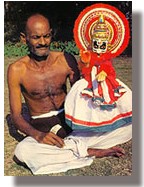
- Pavakoothu, Kerala: In Kerala, the traditional glove puppet play is called Pavakoothu. It came into existence during the 18th century due to the influence of Kathakali, the famous classical dance-drama of Kerala, on puppet performances. In Pavakoothu, the height of a puppet varies from one foot to two feet. The head and the arms are carved of wood and joined together with thick cloth, cut and stitched into a small bag.The face of the puppets are decorated with paints, small and thin pieces of gilded tin, the feathers of the peacock, etc. The manipulator puts his hand into the bag and moves the hands and head of the puppet. The musical instruments used during the performance are Chenda, Chengiloa, Ilathalam and Shankhathe conch. The theme for Glove puppet plays in Kerala is based on the episodes from either the Ramayana or the Mahabharata.



























